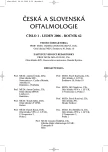Surgical Treatment of Combined Injuries of the Anterior and Posterior Segment of the Eye with Intraocular Metallic Foreign Body
Chirurgické řešení kombinovaných poranění předního a zadního segmentu s kovovým nitroočním tělesem
Cílem práce bylo zhodnotit anatomické a funkční výsledky chirurgického řešení kombinovaných poranění předního a zadního segmentu, způsobených průnikem kovového nitroočního tělesa.
Soubor tvořilo 25 očí s penetrujícím poraněním, způsobeným průnikem kovového nitroočního tělesa. Věkové rozmezí souboru bylo 14–68 let (36,8 ± 10,9) a průměrná doba sledování byla 21,0 ± 10,7 měsíců. Všechna poranění byla řešena suturou vstupní rány s okamžitým či následným řešením patologie na obou segmentech v jednom nebo více sezeních. Kovová tělesa byla extrahována cestou pars plana vitrektomie pinzetou nebo endomagnetem. Traumatické změny na sítnici byly ošetřeny endodiatermií a endolaserem. V indikovaných případech byla provedena tamponáda silikonovým olejem. Parciální či totální traumatická katarakta byla odstraněna technikou fakoemulzifikace ze sklerálního přístupu nebo pars plana endofakofragmentací s nebo bez náhrady nitroočním implantátem.
Nejčastější patologií na předním segmentu byla penetrující rána rohovky (72 %) a traumatické změny na duhovce (56 %). Totální katarakta byla přítomna v 56 % případů. V oblasti zadního segmentu se nejčastěji vyskytl hemoftalmus (36 %). Známky endoftalmitidy byly přítomny ve 12 % případů. Interval mezi primární suturou a kombinovaným výkonem na předním a zadním segmentu byl nejčastěji mezi 5.–14. dnem (52 %). U 10 případů (40 %) jsme implantovali nitrooční čočku (IOL), 9krát zadněkomorovou IOL a 1krát předněkomorovou IOL. Z časných pooperačních komplikací jsme zaznamenali nejčastěji výskyt fibrinu v přední komoře (16 %), z pozdních komplikací amoci (32 %) a vznik PVR (24 %).
Anatomický a funkční výsledek kombinovaných poranění s CNT závisí nejen na volbě techniky chirurgického řešení, ale zejména i na rozsahu počátečního poranění a riziku rozvoje přítomné infekce.
Klíčová slova:
penetrující poranění, kovové nitrooční těleso
Authors:
H. Došková; E. Vlková
Authors‘ workplace:
Oftalmologická klinika LF MU a FN, Brno-Bohunice
přednosta prof. MUDr. Eva Vlková, CSc.
Published in:
Čes. a slov. Oftal., 62, 2006, No. 1, p. 42-47
Overview
Goal:
The aim of this study was to establish anatomical and functional results of combined injuries of the anterior and posterior segment of the eye caused by penetration of the metallic foreign body.
Material and methods:
The group consisted of 25 eyes with penetrating injury caused by metallic intraocular body. The age at time of the injury in the group was 14–68 years (36.8 ± 10.9) and the average follow up period was 21.0 ± 10.7 months. All injuries were treated by means of suture of the entering wound with immediate or postponed treatment of the pathologic findings in both segments during one or more procedures. The metallic foreign bodies were extracted with forceps or endomagnetic device during the pars plana vitrectomy. Traumatic changes of the retina were treated by means of endodiathermy and endolaser. Silicone oil tamponade was performed, where indicated. The partial or total traumatic cataract was removed by phacoemulsification through the scleral admittance or by endophaco fragmentation with or without intraocular lens implantation.
Results:
The most common pathological findings were the penetrating wound of the cornea (72 %) and traumatic changes of the iris (56 %). The total cataract was present in 56 % of cases. In the posterior segment, vitreous hemorrhage was most frequent (36 %). Signs of endophtalmitis were present in 12 % of cases. The period between the primary suture and combined procedure at the anterior and posterior segment was mostly 5–14 days (56 %). In ten cases (40 %), the intraocular lens (IOL) was implanted, 9 times in the posterior and once in the anterior chamber. Out of the early postoperative complications, the fibrin in the anterior chamber was noticed most frequently (16 %), and out of the late ones, the retinal detachment (32 %) and proliferative vitreoretinopathy (24) were most common.
Conclusion:
Anatomical and functional result of the combined injury with the foreign intraocular body depends not only on the choice of the surgical technique, but predominantly on the extent of the initial injury and risk of the present infection’s spreading.
Key words:
penetrating injury, metallic intraocular foreign body
Labels
OphthalmologyArticle was published in
Czech and Slovak Ophthalmology

2006 Issue 1
Most read in this issue
- Ultrasound Biomicroscopy of the Eye before and after the Cataract Surgery
- Possibilities and Limitations of the Surgery of the Eye’s Posterior Segment under the Outpatient Conditions
- Evaluation of Results of the Penetrating Injuries with Intraocular Foreign Body with the Ocular Trauma Score (OTS)
- Correction of the Astigmatism with the Artisan®
